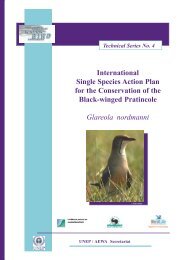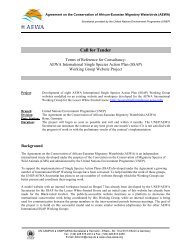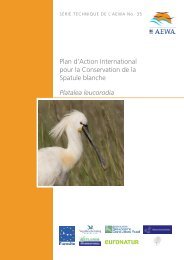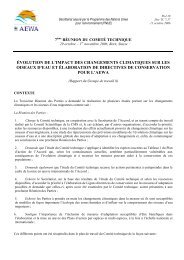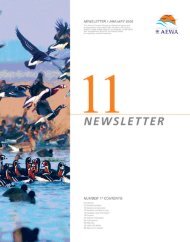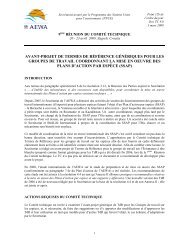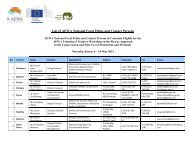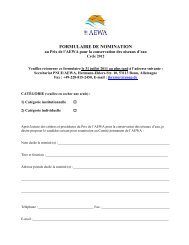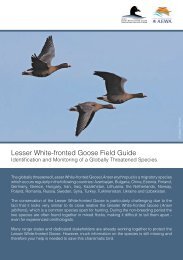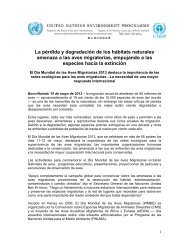International Single Species Action Plan for the ... - AEWA
International Single Species Action Plan for the ... - AEWA
International Single Species Action Plan for the ... - AEWA
Create successful ePaper yourself
Turn your PDF publications into a flip-book with our unique Google optimized e-Paper software.
<strong>AEWA</strong> Technical Series No. 36 - Annexes<br />
2004a). This has also been confirmed by satellite telemetry (Lorentsen et al 1998; Øien et al<br />
1999; Karvonen & Markkola 1997). There is also a staging area fur<strong>the</strong>r east in Kazakhstan:<br />
<strong>the</strong> lake areas surrounding <strong>the</strong> huge lake Tengiz, as indicated by <strong>the</strong> movements of a Lesser<br />
White-front satellite tagged in <strong>the</strong> Taymyr peninsula in 1998 (Øien et. al. 1999).<br />
Three individuals were recorded in south-east Kazakhstan (about 100km west of Almaty) in<br />
March 2003, indicating possible spring staging in this region of birds arriving from wintering<br />
areas fur<strong>the</strong>r south (Yerokhov 2004), though it appears unclear which breeding population<br />
was involved.<br />
The species is included in <strong>the</strong> national Red Data Book and legally protected.<br />
Lithuania (EU)<br />
Vernacular name: Mažoji žąsis<br />
There is a lack of in<strong>for</strong>mation on <strong>the</strong> species’ status, but it can be assumed that birds of <strong>the</strong><br />
Fennoscandian population pass through Lithuania regularly during both spring and autumn<br />
migration. Flocks of up to 800 birds were recorded from <strong>the</strong> Nemunas Delta and Kurshiu<br />
Lagoon prior to <strong>the</strong> 1960s. Subsequently, only very small numbers were recorded, until 1995,<br />
when up to 230 staging birds were observed in <strong>the</strong> Nemunas Delta and small flocks were also<br />
recorded at coastal sites in <strong>the</strong> autumns of 1996 and 1997 (Stoncius and Markkola 2000).<br />
In July 2000, Lesser White-fronted Goose was included in category 4 of <strong>the</strong> Lithuanian Red<br />
Data Book. Lack of in<strong>for</strong>mation concerning <strong>the</strong> species’ occurrence in Lithuania precluded its<br />
inclusion in a higher category. In July 2005 <strong>the</strong> species was deleted from <strong>the</strong> list of <strong>the</strong> Red<br />
Data Book.<br />
Ne<strong>the</strong>rlands (EU)<br />
Vernacular name: Dwerggans<br />
Lesser White-fronted Geese were always rare in <strong>the</strong> Ne<strong>the</strong>rlands. In 1981 a<br />
supplementation/reintroduction project was set up in Swedish Lapland to guide <strong>the</strong> geese via<br />
a comparatively safer route to <strong>the</strong> North Sea countries (to The Ne<strong>the</strong>rlands). Nowadays every<br />
winter some 80-100 birds are seen in <strong>the</strong> Ne<strong>the</strong>rlands.<br />
Birds have been recorded regularly from sites in Friesland, Noord-Holland, Zuid-Holland and<br />
Zeeland (e.g. van Roomen et al 2003).<br />
The SOVON report 2005/06 (Koffijberg et al. 2005) describes an increase from ca 20<br />
individuals around 1990 to ca 120 from 2003/04 onwards. Average peak numbers vary from<br />
50 individuals near Anjum to 5 elsewhere. 87% of all observations of Lesser White-fronts<br />
took place at 6 core sites. The majority of birds sighted are of Swedish origin. Koffijberg et<br />
al. (2005) estimated that 96% of <strong>the</strong> supplemented/reintroduced Swedish birds winter in <strong>the</strong><br />
Ne<strong>the</strong>rlands. Two breeding attempts are recorded, possibly of birds with feral origin.<br />
Norway<br />
Vernacular name: Dverggås (Norwegian); Gilljobás (Lappish/Sami)<br />
The current estimate <strong>for</strong> <strong>the</strong> Fennoscandian population (excluding <strong>the</strong> Kola Peninsula) is 20-<br />
30 pairs (Tolvanen et al. 2004b). The breeding areas of <strong>the</strong>se birds are not known at present,<br />
and some <strong>the</strong>se birds may breed in Finnish and/or Swedish Lapland. Nor<strong>the</strong>rn Norway also<br />
has a key spring and autumn staging area <strong>for</strong> Lesser White-fronted Goose, namely <strong>the</strong> Valdak<br />
Marshes (e.g. Aarvak & Øien 2004). O<strong>the</strong>r important Norwegian sites include <strong>the</strong><br />
Varangarfjord area, <strong>the</strong> Tana River valley and Høyholmen. Statistical analysis of data from<br />
<strong>International</strong> <strong>Single</strong> <strong>Species</strong> <strong>Action</strong> <strong>Plan</strong> Lesser White-fronted Goose –Annexes<br />
XIII



